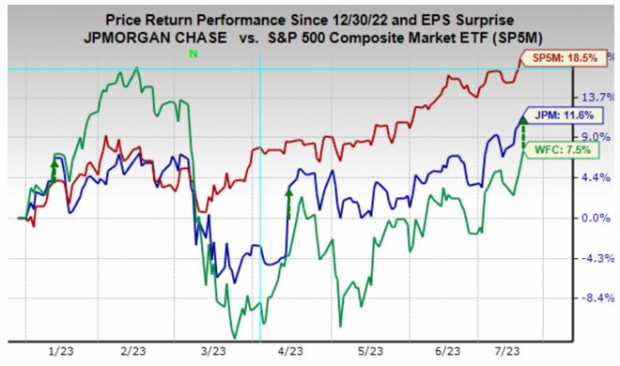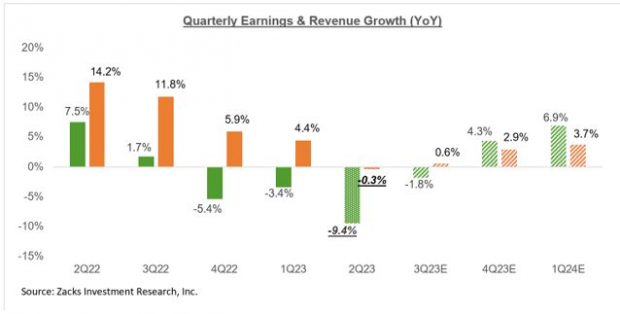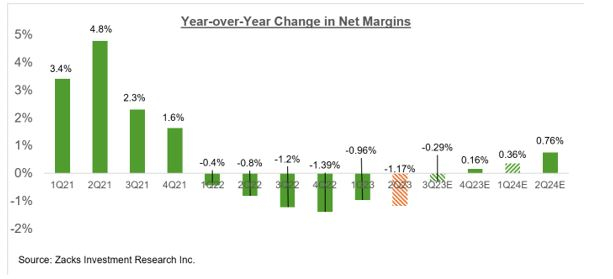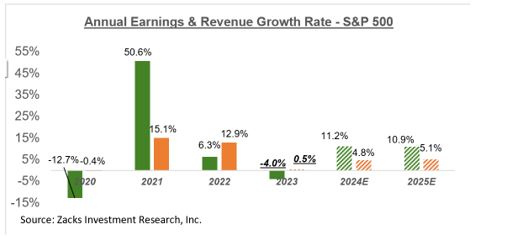Q2 Earnings Season: A Good Start So Far
Image Source: Unsplash
The market liked what it saw in the quarterly releases from JPMorgan (JPM - Free Report), Citigroup (C - Free Report), and even Wells Fargo (WFC - Free Report). There was plenty to like in these results, with the resilient economy helping keep credit demand positive and higher interest rates allowing them to charge more for those loans.
The bank worries that took center stage in the wake of the Silicon Valley Bank fiasco didn’t pertain to these big players. JPMorgan, Citi, and Wells Fargo, which reported Friday morning, and Bank of America, which is scheduled to report Tuesday morning (July 18th), regularly go through the Fed’s stress tests and are perceived as very safe.
The diminished confidence in the banking space has been specifically centered on the small and mid-sized regional banks that will start reporting results this week. The flight to safety among depositors has forced these banks to offer much higher deposit rates to stem the tide. This will show up in net-interest margin pressures relative not only to what came through from the likes of JPMorgan, Citi, and Wells Fargo Friday morning but also relative to what these same banks had reported in the preceding period.
We should also note that even the big players have to offer higher rates to depositors, pressuring their net interest margins. The Q2 net interest margin at JPMorgan, Citi, and Wells was still up from the year-earlier period but has notably leveled off relative to what they reported in the preceding quarter.
Getting back to the group’s Q1 results, the fact that the investment banking business was weak in the period was no surprise for the market. This has been the trend for several quarters, as tighter monetary policy and other macroeconomic headwinds have weighed on deal-making. While there are some ‘green shoots’ on the horizon with respect to M&A and IPO activities, no significant improvement is expected in these businesses until the macroeconomic ‘clouds’ lift.
JPMorgan’s net interest income jumped +44%, as average loans increased +13%, while the same at Wells Fargo increased +29% and +2%. JPMorgan benefited from the First Republic purchase, but the bank’s net interest income would still be up +38% when excluding the troubled lender’s distressed purchase.
Net interest margin for these banks was up relative to the same period last year but was flat to modestly down on a sequential basis as they were forced to pay up for attracting and retaining deposits, which were modestly down at all three banks. Trends in deposits will be a major area that investors will be watching closely with the regional banks in the days ahead.
Another area of potential read-through from these reports concerns commercial real estate exposure, which is a far bigger line of business for the regional operators than for the likes of JPMorgan, Citi, and Wells Fargo. Of these three, Wells Fargo is perhaps more relevant. The bank booked a $949 million increase in ‘reserves,’ a big part of which reflected the Wells’ commercial real estate exposure.
Per Wells’ earnings release, “While we haven’t seen significant losses in our office portfolio to date, we are reserving for the weakness that we expect to play out in that market over time.” Wells had booked $643 million in the preceding period and $235 million in the year-earlier period.
Management’s commentary about the economic outlook reflected tentativeness, citing continued downside risks, though they acknowledged the economy’s resiliency. Given bankers’ inherent defensiveness, the absence of ‘hurricanes’ in Jamie Dimon’s comments is seen as positive and reassuring.
Bank stocks have notably lagged the broader market, particularly since the onset of regional bank worries in March. The chart below shows the year-to-date performance of JPMorgan and Wells Fargo relative to the S&P 500 index.

Image Source: Zacks Investment Research
The issue with the bank stocks isn’t so much their current earnings power but rather how their profitability will shape up in the coming economic slowdown. Bank investors are wary of the group’s track record of making a lot of money during the good times, which the group then gives back during the bad times. The question is how ‘bad’ will the coming ‘bad times’ be for the economy and what will that do to bank earnings.
Regarding the Finance sector scorecard for Q3, we now have results from 18.6% of the sector’s market capitalization in the S&P 500 index. Total earnings for these companies are up +25.2% from the same period last year on +18.9% higher revenues, with 83.3% beating EPS estimates and 50% beating revenue estimates.
Looking at the Finance sector as a whole, total Q2 earnings for the sector are expected to be up +12% on +7% higher revenues.
For the Zacks Major Banks industry, which includes all of the aforementioned banks and accounts for roughly 40% of total Finance sector earnings, total Q2 earnings are on track to be up +14.2% from the same period last year on +11.5% higher revenues.
The table below shows the sector’s Q2 earnings and revenue expectations at the ‘medium’ industry level in the context of what the space reported in the preceding period and what is expected in the following quarter.

Image Source: Zacks Investment Research
As noted earlier, skeptics of the banking industry argue that the group gives away all the profits it had accumulated during the good times when the macro environment turns south. The Covid downturn was an anomaly in that respect, but there is some truth to the allegation.
We will see how the economic picture unfolds in the coming quarters. Still, the credit quality metrics in the reported Q2 results do not point towards a material deterioration, even though delinquencies have started rising from the record low levels of the Covid years.
The earnings growth picture for the Finance sector is expected to improve in 2023 as we turn the page on tough comparisons, even though the economic growth pace is expected to moderate under the cumulative weight of the Fed’s tightening. Finance sector earnings are expected to be up +8.5% in 2023, following the -16.1% earnings decline in 2022.
The Earnings Big Picture
Regular readers of our earnings commentary know that we have consistently been flagging a favorable turn in the revisions trend since the start of 2023 Q2, with earnings estimates stabilizing in the aggregate after consistently coming down for almost a year and actually starting to go up for some key sectors.
It is this combination of favorable macroeconomic developments and optimism about the transformational power of artificial intelligence (AI) that appears to be driving market optimism.
To get a sense of what is currently expected, look at the chart below that shows current earnings and revenue growth expectations for the S&P 500 index for 2023 Q2 and the following three quarters and actual results for the preceding four quarters.

Image Source: Zacks Investment Research
As you can see in this chart, Q2 is on track to be the third quarter in a row of earnings declines and the first quarter of declining revenues. We should point out here that a big part of the earnings and revenue weakness is due to the Energy sector. Excluding the Energy sector drag, Q2 earnings would be only down -3.8% on +2.9% higher revenues.
The chart below shows the year-over-year change in net income margins for the S&P 500 index.

Image Source: Zacks Investment Research
As you can see above, 2023 Q2 will be the 6th consecutive quarter of declining margins for the S&P 500 index.
Margins in Q2 are expected to be below the year-earlier level for 12 of the 16 Zacks sectors, with the biggest margin pressure expected to be in the Basic Materials, Construction, Energy, Medical, Conglomerates, Autos, Aerospace, and Tech sectors.
On the positive side, the Finance sector is the only one expected to experience significant margin gains, with the Consumer Discretionary and Transportation sectors as distant second and third. Sectors expected to be essentially flat margins relative to 2022 Q2 are Retail, Utilities, and Industrial Products.
The chart below shows the earnings and revenue growth picture on an annual basis.

Image Source: Zacks Investment Research
As noted earlier, the estimate revisions trend has notably stabilized since the start of Q2. In the aggregate, S&P 500 earnings estimates for 2023 have declined -1.05% since the beginning of April but only -0.4% on an ex-Energy basis. Importantly, estimates for sectors like Tech, Construction, Autos, and Transportation have actually increased in that timeframe.
Q2 Earnings Scorecard
Including this morning’s big bank results, we now have Q2 earnings season results from 30 S&P 500 members. Total earnings for these 30 index members are up +5.9% from the same period last year on +8.5% higher revenues, with 83.3% beating EPS estimates and 66.7% beating revenue estimates.
The reporting cycle will start ramping up this week, with almost 150 companies coming out with Q2 results, including 57 S&P 500 members. While a big part of this week’s line-up is comprised of banks, we do have some high-profile bellwethers coming out with results. These include Netflix, IBM, Johnson & Johnson, Tesla, and others.
The comparison charts nevertheless put the Q2 results from these 30 index members with what we had seen from the same group of companies in other recent periods.

Image Source: Zacks Investment Research
The comparison charts below put the Q2 earnings and revenue growth rates for these 30 index members in a historical context.

Image Source: Zacks Investment Research
More By This Author:
Q2 Results Likely To Reflect A Stabilizing Earnings Picture
The Q2 Earnings Season Kicks Off
The Earnings Picture Refuses To Weaken
Disclosure: Zacks.com contains statements and statistics that have been obtained from sources believed to be reliable but are not guaranteed as to accuracy or completeness. References to any specific ...
more



